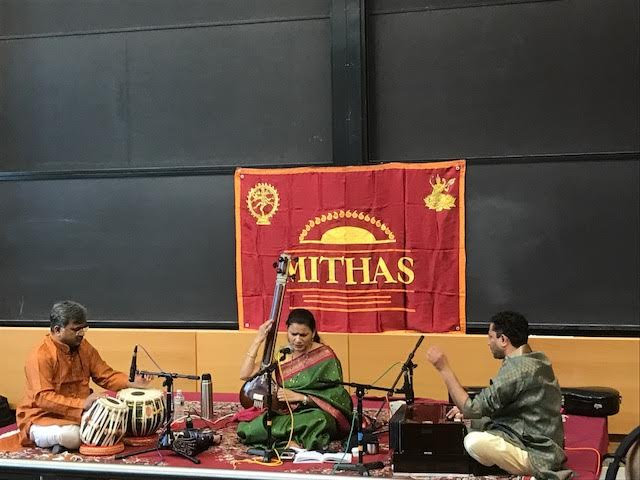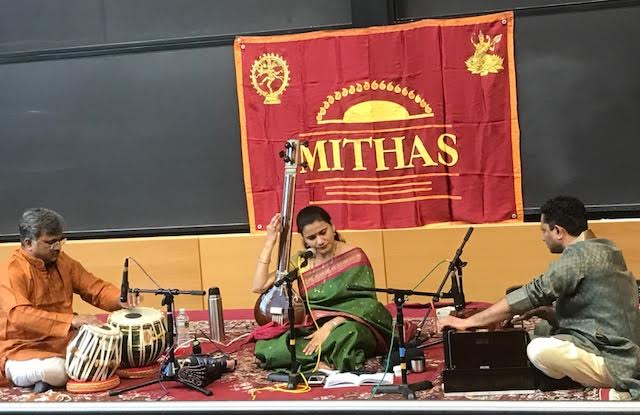Contribute
| Carrying On A Timeless Tradition….. |
Shuchita Rao
05/18/2017
Carrying on a Timeless Tradition…..
Nuanced swaras and creative play with rhythm merged to create an immersive experience in afternoon and evening ragas in Hindustani classical vocalist Smt. Rachna Bodas’s concert at MIT’s Wong auditorium on May 7. She was accompanied on the harmonium by Shri Ramachandra Joshi and on the tabla by Shri Girish Nalawade. The concert was a presentation by MITHAS (MIT Heritage of South Asia) organization which has worked for over two decades to enrich our culture by providing exposure to the great heritage and tradition.
A graded artist of All India Radio, Smt. Rachna Bodas, is a post-graduate in music from Pune University, India and a Sangeet Visharad from Gandharva Mahavidyalaya. She learned from the eminent artists of Gwalior gharana, the late Shri Kashinath Bodas and his sister, the late Vidushi Smt. Veena Sahasrabuddhe. . Dr. George Ruckert introduced the artists and in his welcome address to the audience, he said “Veenatai dazzled us each time and here we have one of her main disciples singing for us.â€
Several khyals and tarana compositions in three ragas followed by a Kabir Bhajan in Raga Bhairavi were presented in the 3 hour long program. The opening raga was afternoon raga Bhimpalasi. Smt. Rachna Bodas presented nuanced alaaps in the lower and middle octaves to establish the landscape of the raga and then sang a slow composition “E birha bamana saguna bichaare†set to 16 beat cycle. After presenting alaaps in the sthayi and antara sections, the artist increased the tempo and presented bol-alaaps and taans that spanned multiple octaves. In the drut khyaal “Piya paas leja†set to addha teentaal (16 beats), several attractive bol-taans and baraabar taans were presented with command. In a fast paced tarana set to 12 beat cycle ektaal, “Tadiyana re, tadiyana re, tadiyana reâ€, a variety of taans launched at different musical notes such as “Saâ€, “ga†“Ma†and “Pa†landed unfailingly on the sum (first beat of the rhythm cycle).
Following raga Bhimapalasi, three compositions in raga Puriya Dhanashri were presented. The first composition “Tere Darshan keâ€, was set to medium tempo jhaptaal (10 beat rhythm cycle) with the mukhda (opening phrase) culminating on the plaintive komal dhaivat note. Smt. Rachna Bodas sang a variety of taans in the well known traditional composition “Mushkil karo aasaan†set to 16 beat cycle teentaal. The ensuing trivat composition by the composer, the late Pandit Balwantrai Bhatt,a blend of sargam, tarana and percussion syllables had pleasing architecture and was presented with energy. The accompanists deserve special mention for their spirited accompaniment on the harmonium and tabla.
Post-intermission, Smt. Rachna Bodas presented three compositions in raga Narayani. “Saguna bichari re bamana†set to slow temp 12 beat cycle ektaal was followed by the late Pandit S.N Ratanjankar’s composition Ssahela ri gaavo ri aaj†and a tarana “Tanaderena deemâ€. Dynamic development of the raga with several aakaar taans rendered with vigor brought memories of the eminent vocalist, the late Smt. Veena Sahasrabuddhe, who groomed the artist.
The concert ended with devotional fervor with the presentation of a bhajan “Ma baawra bhayo†in raga Bhairavi set to a variation of 8 beat cycle keherwa taal. Listeners in the audience who included connoisseurs as well as students who did not have any experience listening to Hindustani music marked how touched they were by the music presented. “I could sense that raga melodies generate positive, upbeat as well as sad emotions. I liked the songs that made me happy†said Holly Hi who originally hails from China. This concert was her introduction to Hindustani classical music. Kudos to the artists, organizers and volunteers for presenting a pleasing concert.
Shuchita Rao of Lokvani spoke to Smt. Rachna Bodas.
1. Were you born in a musical family? Were your parents or grandparents musicians?
I was born in a family where music was always around. I grew up listening to all the well-known, renowned maestros of music. My grandfather used to play sitar. My father, Shri. Ravi Shukla is himself an accomplished tabla player and has accompanied distinguished musicians. Though he did not take to playing tabla as a profession, it has been more than just a hobby for him.
2. At what age did you start singing? Could you name your music teachers and mentors?
I don’t exactly remember what age I started singing. My father saw music in me and he started teaching me bhajans and old Lataji’s songs. He made me participate in various competitions. At the age of 12, I participated in All India light music competition and stood first in that for my age group. It was then that my father thought of me getting formal training. I was very fortunate that Pt. Kashinath Bodas ji agreed to teach me and classical training started from there in1992. I learned for 3 years from him. After Guru ji's sad, unexpected demise, I started my training under his sister Smt. Veena Sahasrabuddhe ji.
3. Can you describe what you learned under your Guru and father-in-law, Pandit Kashinath Bodasji?
I was introduced to the basics of Hindustani classical music and raagdaari in a very loving manner by Pandit Kashinath Bodasji. I learned sargam-geet, khayal and tarana in ragas such as Yaman, Bhimpalasi, Des and Tilak Kamod. He also taught me bhajans and instilled reverence for music in me.
4. Tell us more about what you know about Kanpur’s well-known Bodas family. Did you ever meet your grand father-in-law, the influential musician-cum-teacher, the late Pandit S.S. Bodasji?
Since my childhood I was familiar with the Bodas family. Being from Kanpur, I had heard about their contribution and awareness for music. Dadaji, (Pandit S.S Bodasji) invited all the renowned maestros in music who not only performed but also stayed with Bodas family in Kanpur. The same practice was continued by my Guru Pt. Kashinath Bodasji. Unfortunately I never got the opportunity to see or meet my grandfather-in-law as he passed away way before I started learning from my father-in-law. I wish I at-least met him once. I must say that I feel very happy and blessed to have become a part of the Bodas family.
5. What do you like about your aunt-in-law, the late Vidushi Smt. Veena Sahasrabuddheji’s music?
My Guru and aunt-in-law Smt. Veena Sahasrabuddhe ji’s music is divine. The expression, soulfulness, surilapan, taiyari and the way of looking towards the Ragas and her compositions is what I like about her music.
6. Would you say that you sing primarily in the style of Gwalior gharana or do you also incorporate features of other gharanas in your music? What would you say are the main characteristics of your khayal gaayaki?
I would say that I sing what my Guru taught me. She never forced or imposed any kind of Gharana on any of her students. My guru Veena Tai developed her own unique style (gaayaki) which has the beauty of Gwalior Gharana and also incorporates aesthetically and artistically the uniqueness of other gharanas.
When it comes to khayal gayaki I would say, as it describes from its name “Khyal†meaning “Imaginationâ€, developing a raag depends on the mood of that raag. I feel it is like a flower bud opening up slowly and reaching to its full blossoming stage. In the same way a raag is unfolded and developed with the imagination of an artist.
7. Did you make a personal choice to be a full-time professional vocalist?
I received Sangeet Visharad degree from Gandharva Mahavidyalay, Kanpur. Later, I took admission in Centre for performing arts Pune for my masters degree just to be able to get regular music lessons from Veena Tai as she lived in Pune. I think being a full time professional vocalist gradually happened and yes, it was my personal choice.
8. What are the challenges of staying devoted to performing only classical music? Have you felt the need to explore new avenues such as singing for Kathak dance, doing play-back singing or collaborating with musicians who specialize in musical genres other than Hindustani music?
I would not say that it is a challenge staying devoted to performing only classical music. It is one’s own choice. I feel that all musical genres are branches of classical music. Every music is developed with the same seven notes which we use in classical music. I don’t mind exploring something new if I can give justice to it and it suits me.
9. How would you describe the word “riyaaz� What is your method of daily riyaaz?
I think riyaaz can be described as ‘sadhana’. It is the most important and integral part of any musician’s life. I follow the method that my Gurus taught me which is the riyaaz of shuddha swaras (regular notes) in mandra (lower), Madhya(middle) and taar(upper) saptak followed by the swaras (notes) of the specific raga that needs to be practiced.
10. Other than music, what are your interests?
I love to cook. I would say that cooking is a stress-reliever for me. I like to explore cuisines other than Indian such as Mexican and Italian cuisines.
11. Do you have a grand dream for your life or a personal ambition to fulfill?
I would say that my dream is to carry forward the musical legacy of my gurus and to stay committed to my music with love and devotion.
You may also access this article through our web-site http://www.lokvani.com/

